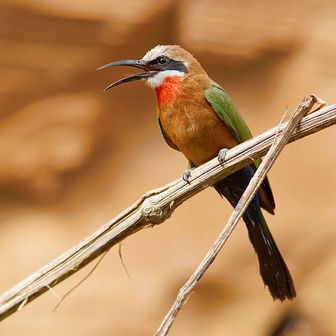White-fronted Bee-eater
They have a distinctive white forehead, a square tail and a bright red patch on their throat. They nest in small colonies, digging holes in cliffs or earthen banks but can usually be seen in low trees waiting for passing insects from which they hunt either by making quick hawking flights or gliding down before hovering briefly to catch insects.

The White-fronted Bee-eater is classified as Least Concern. Does not qualify for a more at risk category. Widespread and abundant taxa are included in this category.
The White-fronted Bee-eater has a complex colonial social life Green Bee-eaters dust bathing to keep down parasites The bee-eaters are diurnal (active by day) although a few species may migrate during the night if the terrain on route is unsuitable for stopping or if they are crossing the sea. They are a highly social family. Pairs sitting together are often so close together that they touch (described as having an individual distance of zero). More
The White-fronted Bee-eater, Merops bullockoides, is a species of bee-eater widely distributed in sub-equatorial Africa. They have a distinctive white forehead, a square tail and a bright red patch on their throat. They nest in small colonies, digging holes in cliffs or earthen banks but can usually be seen in low trees waiting for passing insects from which they hunt either by making quick hawking flights or gliding down before hovering briefly to catch insects. More
* White-fronted Bee-eater Colony of bee-eaters with nest holes in the bank of the Chobe River Chobe National Park, Botswana (ssp bullockoides) Susanne Rintelen 13 June 2004 27 weeks ago 3 Sounds 0 recordings * No sound recordings available yet * Send or share this page * Email this pageEmail this page More
The White-fronted Bee-eater, Merops bullockoides, is a species of Bee-eater widely distributed in sub-equatorial Africa. This species, like other bee-eaters, is a richly colored, slender bird, with a distinctive black mask, white forehead, square tail and a bright red throat. More
White-fronted Bee-eaters have been described as "the most complex of any bird species anywhere in the world". The birds exist in stable colonies located on nesting cliffs, and have a stable structure year round. These colonies are composed of clans of two or three pairs, their helpers, and offspring. Within the colony the males alternate between guarding their mate and attempting to make forced copulations other females. The females in turn attempt to lay eggs in their neighbour's nests. More
White-fronted bee-eater perched on elephant dung© Tony Heald / naturepl.com White-fronted bee-eater on a branch© Pete Oxford / naturepl.com White-fronted bee-eater perched© Ariadne Van Zandbergen / www.flpa-images.co.uk White-fronted bee-eaters on a branch© Richard Du Toit / naturepl.com A group of white-fronted bee-eaters perched© Heather Angel / naturalvisions.co.uk White-fronted bee-eaters perched© Ian Tait / naturalvisions.co.uk White-fronted bee-eaters on a branch© Hayden Oake / www.ardea. More
White-fronted bee-eater on a branch White-fronted bee-eater on a branchPrint factsheet Facts - French: Guêpier À Front Blanc Kingdom Animlia Phylum Chordata Class Aves Order Coraciiformes Family Meropidae Genus Merops (1) More
White-fronted Bee-eater Merops / User:Sarefo / LicenseCC-by-sa - Attribution Share Alike Merops White-fronted Bee-eater / Jacqui Goodw.. / LicenseCC-by-nc-nd - Attribution Non-commercial No Derivatives White-fronted Bee-eater Slide_show_arrows 1 of 3 White-fronted Bee-eater / Sander Kuulk.. / LicenseGFDL - Gnu Free Document License Members of many animal communities improve the survival of the group by self-sacrificing time, energy, and resources. More
White-fronted bee-eaters are found in the river banks and gullies of wooded grassland and pastures of sub-equatorial Africa. Their diet of insects, which is almost always honey bees, is caught either through rapid flight down from a low tree perch or during a slower hovering flight. These bee-eaters live in a very complex society, nesting in colonies made up of family clans where non-breeding birds become helpers for their breeding relatives. More
The White-fronted bee-eater is endemic to Africa, being found from Gabon and Uganda south to southern Africa, where it prefers areas with grasslands, broad-leaved woodland and bushy pastures. It feeds exclusively on insects, mostly the Apis mellifera (Honey bee) but also bugs, wasps etc. It has one of the most complicated societies of all birds, with each colony, which is made up of 10-20 nests dig into riverbanks or gullies. Colonies comprising a number of groups, known as clans. More
The White-fronted Bee-eater is a Southern African bird that belongs to the Meropidae bird family group which includes birds such as Bee eaters. The description for the White-fronted Bee-eater (Latin name Merops bullockoides) can be found in the 7th Edition of the Roberts Birds of Southern Africa. The Merops bullockoides can be quickly identified by its unique Roberts identification number of 443 and the detailed description of this bird is on page 186. More
Results for: white-fronted bee-eaterTranslations 1 - 30 of 922 English English Finnish Finnish white-fronted bee-eater jokimehiläissyöjä, Merops bullockoides white-throated bee-eater aavikkomehiläissyöjä, Merops albicollis white-fronted tit valko-otsatiainen, Parus semilarvatus white-fronted swift huurreotsakiitäjä, Cypseloides storeri white-fronted parrot valko-otsa-amatsoni, Amazona albifrons white-fronted plover hietatylli, Charadrius marginatus white-fronted redstart More
The White-Fronted Bee-Eater's (Merops bullockoides) diet is made up primarily of bees, but they also take other flying insects depending on the season and availability of prey. I photographed this guy near his colony in a riverbank in Botswana. More

Original source: David Bygott
Author: David Bygott
Permission: Some rights reserved
Family : Meropidae
Genus : Merops
Species : bullockoides
Authority : Smith, 1834

